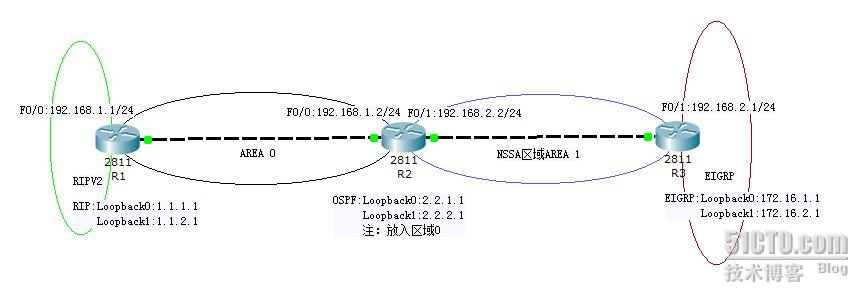BSCI—8-(2):OSPF的特殊区域类型与配置
2010-02-02 17:04
459 查看
BSCI—8-(2):OSPF的特殊区域类型与配置

2010-01-29 09:10:48
标签:OSPF BSCI 特殊区域 [推送到技术圈]

2010-01-29 09:10:48
标签:OSPF BSCI 特殊区域 [推送到技术圈]
| 版权声明:原创作品,允许转载,转载时请务必以超链接形式标明文章 原始出处 、作者信息和本声明。否则将追究法律责任。/article/4464078.html |
| 一、NSSA区域: 1.只有NSSA区域中才会现LSA7,可以存在ASBR,阻止LSA4/5 2.ABR将LSA7转成LSA5,传播到其他区域,这时,ABR也成为了ASBR,因为它也引入了LSA5,其它路由器看到LSA5的通告路由器是ABR。 二、实验拓扑如下:R1到R2属区域0,R2到R3属区域1并配置为NSSA区域,R1与R3分别运行RIP与EIGRP模拟OSPF外部路由,接口与IP地址信息如下所示.  步骤一:配置3台路由器及路由协议,并如图发布网段. R1: Router> Router>en Router#conf t Router(config)#hostname R1 R1(config-line)#exit R1(config)#interface f0/0 R1(config-if)#ip address 192.168.1.1 255.255.255.0 R1(config-if)#no sh R1(config-if)#exit R1(config)#interface loopback 0 R1(config-if)#ip address 1.1.1.1 255.255.255.0 R1(config-if)#ip ospf network point-to-point //防止学习32位的主机路由 R1(config-if)#int lo1 R1(config-if)#ip address 1.1.2.1 255.255.255.0 R1(config-if)#ip ospf network point-to-point //防止学习32位的主机路由 R1(config-if)#exit R1(config)#router ospf 1 //启用OSPF路由协议 R1(config-router)#router-id 1.1.1.1 //指定ROUTE-ID R1(config-router)#network 192.168.1.1 0.0.0.0 area 0 //发布网段到区域0 R1(config-router)#exit R1(config)#router rip //启用RIP路由协议 R1(config-router)#version 2 //指定版本2 R1(config-router)#no auto-summary //不要自动汇总 R1(config-router)#network 1.1.1.0 //发布网段 R1(config-router)#network 1.1.2.0 //同上 R1(config-router)#end R1# R2: start Router> Router>en Router#conf t Router(config)#hostname R2 R2(config)#interface f0/0 R2(config-if)#ip address 192.168.1.2 255.255.255.0 R2(config-if)#no sh R2(config-if)#exit R2(config)#interface f0/1 R2(config-if)#ip address 192.168.2.2 255.255.255.0 R2(config-if)#no sh R2(config-if)#exit R2(config)#interface loopback 0 R2(config-if)#ip address 2.2.1.1 255.255.255.0 R2(config-if)#ip ospf network point-to-point R2(config-if)#int lo1 R2(config-if)#ip address 2.2.2.1 255.255.255.0 R2(config-if)#ip ospf network point-to-point R2(config-if)#exit R2(config)#router ospf 1 //启用OSPF路由协议 R2(config-router)#router-id 2.2.2.2 //同上 R2(config-router)#network 192.168.1.2 0.0.0.0 area 0 R2(config-router)#network 192.168.2.2 0.0.0.0 area 1 R2(config-router)#network 2.2.1.1 0.0.0.0 area 0 R2(config-router)#network 2.2.2.1 0.0.0.0 area 0 R2(config-router)#end R2# R3: Router> Router>en Router#conf t Router(config)#hostname R3 R3(config)#interface f0/1 R3(config-if)#ip address 192.168.2.1 255.255.255.0 R3(config-if)#no sh R3(config-if)#exit R3(config)#interface loopback 0 R3(config-if)#ip address 172.16.1.1 255.255.255.0 R3(config-if)#int lo1 R3(config-if)#ip address 172.16.2.1 255.255.255.0 R3(config-if)#exit R3(config)#router ospf 1 //启用OSPF路由协议 R3(config-router)#router-id 3.3.3.3 //同上 R3(config-router)#network 192.168.2.1 0.0.0.0 area 1 R3(config-router)#exit R3(config)#router eigrp 1 R3(config-router)#no auto-summary R3(config-router)#network 172.16.1.0 0.0.0.255 R3(config-router)#network 172.16.2.0 0.0.0.255 R3(config-router)#end R3# 步骤二:在R1与R3上进行路由的重发布,使得路由器能够互相学习外部路由. R1(config)#router ospf 1 R1(config-router)#redistribute rip subnets //将RIP重发布进OSPF R1(config-router)#exit R1(config)#router rip R1(config-router)#redistribute ospf 1 metric 1 //将OSPF重发布进RIP度量为1 R1(config-router)#end R1# R3(config)#router ospf 1 R3(config-router)#redistribute eigrp 1 subnets //将EIGRP重发布进OSPF R3(config-router)#exit R3(config)#router eigrp 1 R3(config-router)#redistribute ospf 1 metric 100000 5 255 1 1500 //将OSPF重发布进EIGRP,带宽=100000KM 廷迟=5 可靠性=255 负载=1 最大传输单元=1500 R3(config-router)#end R3# 步骤三:将区域1配置为NSSA区域. R2(config)#router ospf 1 R2(config-router)#area 1 nssa //将区域1配置为NSSA R2(config-router)#end R2# R3(config)#router ospf 1 R3(config-router)#area 1 nssa //将区域1配置为NSSA R3(config-router)#end R3# 步骤四:在R1,R2与R3上分别验证 查看R1路由表: R1#show ip route Codes: C - connected, S - static, I - IGRP, R - RIP, M - mobile, B - BGP D - EIGRP, EX - EIGRP external, O - OSPF, IA - OSPF inter area N1 - OSPF NSSA external type 1, N2 - OSPF NSSA external type 2 E1 - OSPF external type 1, E2 - OSPF external type 2, E - EGP i - IS-IS, su - IS-IS summary, L1 - IS-IS level-1, L2 - IS-IS level-2 ia - IS-IS inter area, * - candidate default, U - per-user static route o - ODR, P - periodic downloaded static route Gateway of last resort is not set 1.0.0.0/24 is subnetted, 2 subnets C 1.1.1.0 is directly connected, Loopback0 C 1.1.2.0 is directly connected, Loopback1 2.0.0.0/24 is subnetted, 2 subnets O 2.2.1.0 [110/2] via 192.168.1.2, 00:08:29, FastEthernet0/0 O 2.2.2.0 [110/2] via 192.168.1.2, 00:08:29, FastEthernet0/0 172.16.0.0/24 is subnetted, 2 subnets O E2 172.16.1.0 [110/20] via 192.168.1.2, 00:07:34, FastEthernet0/0 O E2 172.16.2.0 [110/20] via 192.168.1.2, 00:07:34, FastEthernet0/0 C 192.168.1.0/24 is directly connected, FastEthernet0/0 O IA 192.168.2.0/24 [110/2] via 192.168.1.2, 00:08:04, FastEthernet0/0 R1# //R1上可以学习到所有路由,因为它是正常区域,没有做任何配置,可以学习所以类型的LSA 查看R2路由表: R2#show ip route Codes: C - connected, S - static, I - IGRP, R - RIP, M - mobile, B - BGP D - EIGRP, EX - EIGRP external, O - OSPF, IA - OSPF inter area N1 - OSPF NSSA external type 1, N2 - OSPF NSSA external type 2 E1 - OSPF external type 1, E2 - OSPF external type 2, E - EGP i - IS-IS, su - IS-IS summary, L1 - IS-IS level-1, L2 - IS-IS level-2 ia - IS-IS inter area, * - candidate default, U - per-user static route o - ODR, P - periodic downloaded static route Gateway of last resort is not set 1.0.0.0/24 is subnetted, 2 subnets O E2 1.1.1.0 [110/20] via 192.168.1.1, 00:04:19, FastEthernet0/0 O E2 1.1.2.0 [110/20] via 192.168.1.1, 00:04:19, FastEthernet0/0 2.0.0.0/24 is subnetted, 2 subnets C 2.2.1.0 is directly connected, Loopback0 C 2.2.2.0 is directly connected, Loopback1 172.16.0.0/24 is subnetted, 2 subnets O N2 172.16.1.0 [110/20] via 192.168.2.1, 00:04:19, FastEthernet0/1 O N2 172.16.2.0 [110/20] via 192.168.2.1, 00:04:19, FastEthernet0/1 C 192.168.1.0/24 is directly connected, FastEthernet0/0 C 192.168.2.0/24 is directly connected, FastEthernet0/1 R2# //有人肯定会说NSSA区域不是不会学习5类LSA吗,怎么多了2条E2的路由? 因为R2是NSSA的ABR,它所要做的事情就是将7类型LSA转成5类LSA并传播到区域间每个路由器,还有NSSA区域可以学习本区域引入的外部路由,上面两条N2的路由为从R3上EIGRP所学的外部路由. 查看R3路由表: R3#show ip route Codes: C - connected, S - static, I - IGRP, R - RIP, M - mobile, B - BGP D - EIGRP, EX - EIGRP external, O - OSPF, IA - OSPF inter area N1 - OSPF NSSA external type 1, N2 - OSPF NSSA external type 2 E1 - OSPF external type 1, E2 - OSPF external type 2, E - EGP i - IS-IS, su - IS-IS summary, L1 - IS-IS level-1, L2 - IS-IS level-2 ia - IS-IS inter area, * - candidate default, U - per-user static route o - ODR, P - periodic downloaded static route Gateway of last resort is not set 2.0.0.0/24 is subnetted, 2 subnets O IA 2.2.1.0 [110/2] via 192.168.2.2, 00:13:21, FastEthernet0/1 O IA 2.2.2.0 [110/2] via 192.168.2.2, 00:13:21, FastEthernet0/1 172.16.0.0/24 is subnetted, 2 subnets C 172.16.1.0 is directly connected, Loopback0 C 172.16.2.0 is directly connected, Loopback1 O IA 192.168.1.0/24 [110/2] via 192.168.2.2, 00:13:21, FastEthernet0/1 C 192.168.2.0/24 is directly connected, FastEthernet0/1 R3# //R3属于NSSA区域内,而非NSSA区域ABR,所以它就验证了NSSA区域不能学习其它区域引入的外部路由。 疑问:为什么在R2上面会发生7类LSA转5类LSA? 我们来看看R2的OSPF链路状态数据库: R2#show ip ospf database Type-7 AS External Link States (Area 1) Link ID ADV Router Age Seq# Checksum Tag 172.16.1.0 3.3.3.3 1501 0x80000001 0x00C09F 0 172.16.2.0 3.3.3.3 1501 0x80000001 0x00B5A9 0 Type-5 AS External Link States Link ID ADV Router Age Seq# Checksum Tag 1.1.1.0 1.1.1.1 483 0x80000002 0x00A3F4 0 1.1.2.0 1.1.1.1 484 0x80000002 0x0098FE 0 172.16.1.0 2.2.2.2 1495 0x80000001 0x0073FA 0 172.16.2.0 2.2.2.2 1495 0x80000001 0x006805 0 R2# 注:前面说过,只有NSSA区域存放7类LSA,所以7类LSA传播到其它区域根本就不识别,仔细看R2上5类与7类LSA的摘要,都存放了172.16.1.0与172.16.2.0,所以这就7类变5类LSA的转折点. 总结:相信通过这两篇文章,大家对OSPF的特殊区域有个比较好的认识与掌握. 本文出自 “梅岩〃s博客” 博客,请务必保留此出处/article/4464078.html本文出自 51CTO.COM技术博客 |
相关文章推荐
- BSCI—8-(1):OSPF的特殊区域类型与配置(末节与完全末节区域)
- BSCI―8-(2):OSPF的特殊区域类型与配置
- BSCI―8-(2):OSPF的特殊区域类型与配置
- BSCI―8-(1):OSPF的特殊区域类型与配置(末节与完全末节区域)
- BSCI―8-(1):OSPF的特殊区域类型与配置(末节与完全末节区域)
- CCNP第四天(1) 配置、校验OSPF特殊区域类型-Stub区域
- OSPF多区域配置和划分特殊与普通(华为)
- 华为ospf的虚链路和特殊区域配置实例
- 特殊的OSPF区域类型
- 23、OSPF配置实验之特殊区域Totally NSSA
- OSPF特殊区域之stub和totally stub配置(一)
- OSPF特殊区域之stub和totally stub配置(二)
- CCNP第四天(2) 配置、校验OSPF特殊区域类型-完全Stub区域
- 22、OSPF配置实验之特殊区域NSSA
- OSPF特殊区域类型总结
- OSPF特殊区域之NSSA和totally NSSA配置(一)
- OSPF LSA的分组类型和OSPF的特殊区域简单理解
- OSPF特殊区域之NSSA和totally NSSA配置(二)
- 20、OSPF配置实验之特殊区域stub
- 21、OSPF配置实验之特殊区域totally stub
